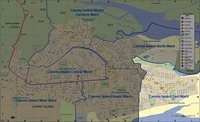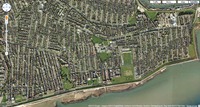 CANVEY ISLAND EAST WARD lies on the eastern point of the island, adjoining the neighbouring wards of Canvey Island North and Canvey Island South.
CANVEY ISLAND EAST WARD lies on the eastern point of the island, adjoining the neighbouring wards of Canvey Island North and Canvey Island South.
In 2007, the two Town Council seats were taken by the Canvey Island Independent Party. The late Christine Andrews obtained 888 votes, just tipping her colleague, Phillip Davies, into second place with 864.
In January 2009, Christine Andrew’s death gave rise to a by-election in which the CIIP just narrowly hung onto the seat after an incursion by the BNP into local politics. Nicola Pontius was returned with just 425 votes against the background of the majority of residents voting for other parties – and against the CIIP.
On a turnout that was around two-thirds lower than in 2007, Colin MacLean (Con) achieved a respectable 328 (28.95 per cent of the vote); and John Payne (Lab) ended-up with 151 votes (13.33 per cent). But the surprise of the night was John Morgan (BNP) who grabbed 229 votes from the two main parties (20.21 per cent).
The CIIP candidate, Nicola Pontius, was forced to limp back to the clubhouse, knowing that 62.49 per cent of residents had voted against her and her party.
Neither Phillip Davies, nor Nicola Pontius, hold Borough Council seats. The Canvey Island East seats are held there by Lee Barrett; John Payne; and Anne Wood (all now of the Canvey Island Independent Party).
Nicola Pontius is one of the few CIIP councillors to actually live in the ward she represents. She resides in May Avenue; whereas Phillip Davies lives in Linden Way, which is part of Canvey Island Central Ward.
Nicola once had a letter published in the Echo entitled ‘You can’t trust hi-tech sirens to warn of flood;’ but, apart from that, seems not to have raised her voice.
Phillip Davies is chairman of the Town Council’s finance committee; but, it seems, he too has little to say in the press.
Canvey Island East contains the island’s Concord Beach Paddling Pool, which gave rise to resident protests when Castle Point Borough Council took a decision to close it. Notably, neither Pontius nor Davies are mentioned amongst the thousands of words devoted to covering the issue in the local press.
 In 2001, Canvey Island East ward was composed of 2,708 dwellings and 6,375 residents with an average age of 40.2 years-old. Four-thousand seven-hundred and ninety-five termed themselves Christians; there were 28 Muslims, 11 Hindus; eight Jewish, six Buddhist, three Sikh and 31 others. One-thousand-and-sixteen said they had no religion and 478 preferred not to comment.
In 2001, Canvey Island East ward was composed of 2,708 dwellings and 6,375 residents with an average age of 40.2 years-old. Four-thousand seven-hundred and ninety-five termed themselves Christians; there were 28 Muslims, 11 Hindus; eight Jewish, six Buddhist, three Sikh and 31 others. One-thousand-and-sixteen said they had no religion and 478 preferred not to comment.
Eleven-point-seven per cent of the population was aged below ten years old. Eleven-point-two per cent was aged between 10 and 19; 11.8 per cent between 20 and 29; 43 per cent were aged between 30 and 50; 15.1 per cent between 60 and 74 – and 7.3 per cent of the population was aged 75 or over.
Essex Police designate the Canvey Island East ward as having an average level of crime.
The Canvey East by-election is interesting because it shows how, just two years into the Town Council’s administration, the CIIP’s support had evaporated. That is illustrated by the extremely low turnout and the fact that the BNP found it so easy to gather the protest vote that the CIIP relies upon for its support. Had the by-election occurred after the Telegraph had broken the MPs’ expenses scandal, the BNP might easily have taken the seat.
It was certainly a good night for the BNP, which had exposed the soft underbelly of right-wing support that exists in both the Conservative and the CII parties. It is that soft underbelly that Bob Spink had correctly identified when he became an MP, and which he sought to target to his own advantage whenever he could. But Spink over-estimated the size of that underbelly within the local Conservative Party (forgetting that many still remember what they fought for in WWII). He also erroneously believed that the island’s influx of London’s East Enders, abandoning their former residences because of the capital’s immigrant influx, could be frightened into believing that the same thing could happen here.
Those beliefs were tested by the BNP in January 2009, when Spink was at his peak and before this Blog had reason to examine his expenses. But both Spink and the BNP were deluded enough to believe that that soft underbelly could be enticed into the right-wing camp by putting forward far-right policies. Neither understood that the majority of the far-right vote consists of protests against the regular parties. But that is a mistake that the far-left never makes.
An unholy alliance once existed between our then MP, Bob Spink, and Blackwell’s CIIP. An alliance between the far-right and the far-left to create discord within the Borough and weaken the Conservative and Labour vote. The strategy has largely been successful in destroying the local Labour party – and it came close to neutering the Conservatives last May when Spink launched his Independent Save Our Green Belt Party in the local government elections.
As illustrated in this 2009 by-election, sowing discord creates apathy among regular party supporters who then stay away from the polls. Those whom are then left, willing to vote, largely consist of those wishing to protest against their regular party by voting for their opponent. (They do this in the belief that the opposing party cannot win – because they had so few votes the last time around). But what actually happens is that the same number of hard-line protesters turn-out to vote as they always do each year – and, because regular voters choose to stay away, their numbers are much more significant than before.
If enough of those disillusioned voters decide to give their normal party a bloody nose by voting for their opponent – the party that they thought could not win can easily snatch the election.
Many would say that is precisely what happened in last year’s local government elections when Tory voters decided to give their party a bloody nose over the expenses scandal and voted CIIP on the island – and ISOGBP on the mainland. Few expected a CIIP landslide here - and many awoke abruptly, the morning following the vote, to catch their breath over what might have been on the mainland.
The Canvey Island East by-election is significant for anyone considering to stand in the Canvey Island Town Council elections this May. In particular, it shows how local, non-political, community leaders could unite disillusioned residents into voting for them instead. The figures clearly show that over 60 per cent of voters in this by-election were so disillusioned with local politics that they chose not to vote at all.
In these Town Council elections: it will not be the local political parties who are able to bring out the voters. If they stand, it will be Church and community representatives leading a movement to abandon politics and gain control of the Town Council’s precious precept for the benefit of all Parish residents – and not just those wards linked to the CIIP leader and current Town Council Chairman (both of whom represent Canvey Island Central ward, which has benefitted most from Town Council spending in the shape of over £180,000 spent on Canvey Lake).
And perhaps we should also not forget over £6,000 of island resident funds that was spent on the abortive Tewkes Creek (now Creaky Woods) tree planting exercise (in Canvey Island’s North ward, and, coincidentally, just a stone’s throw away from where the Canvey Island Independent Party leader, Dave Blackwell, resides)..

No comments:
Post a Comment